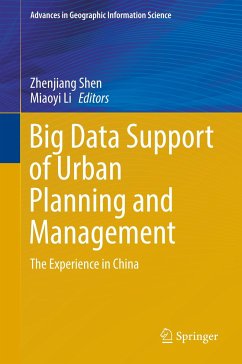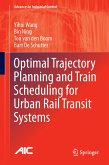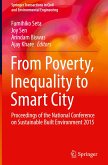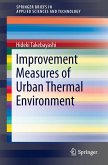Big Data Support of Urban Planning and Management
The Experience in China
Herausgegeben:Shen, Zhen-jiang; Li, Miaoyi
Big Data Support of Urban Planning and Management
The Experience in China
Herausgegeben:Shen, Zhen-jiang; Li, Miaoyi
- Gebundenes Buch
- Merkliste
- Auf die Merkliste
- Bewerten Bewerten
- Teilen
- Produkt teilen
- Produkterinnerung
- Produkterinnerung
In the era of big data, this book explores the new challenges of urban-rural planning and management from a practical perspective based on a multidisciplinary project. Researchers as contributors to this book have accomplished their projects by using big data and relevant data mining technologies for investigating the possibilities of big data, such as that obtained through cell phones, social network systems and smart cards instead of conventional survey data for urban planning support. This book showcases active researchers who share their experiences and ideas on human mobility,…mehr
Andere Kunden interessierten sich auch für
![Urban Transportation Planning in the United States Urban Transportation Planning in the United States]() Edward WeinerUrban Transportation Planning in the United States119,99 €
Edward WeinerUrban Transportation Planning in the United States119,99 €![Optimal Trajectory Planning and Train Scheduling for Urban Rail Transit Systems Optimal Trajectory Planning and Train Scheduling for Urban Rail Transit Systems]() Yihui WangOptimal Trajectory Planning and Train Scheduling for Urban Rail Transit Systems75,99 €
Yihui WangOptimal Trajectory Planning and Train Scheduling for Urban Rail Transit Systems75,99 €![Plant Selection for Bioretention Systems and Stormwater Treatment Practices Plant Selection for Bioretention Systems and Stormwater Treatment Practices]() Hunt William F.Plant Selection for Bioretention Systems and Stormwater Treatment Practices15,99 €
Hunt William F.Plant Selection for Bioretention Systems and Stormwater Treatment Practices15,99 €![From Poverty, Inequality to Smart City From Poverty, Inequality to Smart City]() From Poverty, Inequality to Smart City112,99 €
From Poverty, Inequality to Smart City112,99 €![Improvement Measures of Urban Thermal Environment Improvement Measures of Urban Thermal Environment]() Hideki TakebayashiImprovement Measures of Urban Thermal Environment41,99 €
Hideki TakebayashiImprovement Measures of Urban Thermal Environment41,99 €![District Heating and Cooling Networks in the European Union District Heating and Cooling Networks in the European Union]() Antonio Colmenar-SantosDistrict Heating and Cooling Networks in the European Union67,99 €
Antonio Colmenar-SantosDistrict Heating and Cooling Networks in the European Union67,99 €![Lightweight Landscape Lightweight Landscape]() Lightweight Landscape38,99 €
Lightweight Landscape38,99 €-
-
-
In the era of big data, this book explores the new challenges of urban-rural planning and management from a practical perspective based on a multidisciplinary project. Researchers as contributors to this book have accomplished their projects by using big data and relevant data mining technologies for investigating the possibilities of big data, such as that obtained through cell phones, social network systems and smart cards instead of conventional survey data for urban planning support. This book showcases active researchers who share their experiences and ideas on human mobility, accessibility and recognition of places, connectivity of transportation and urban structure in order to provide effective analytic and forecasting tools for smart city planning and design solutions in China.
Produktdetails
- Produktdetails
- Advances in Geographic Information Science
- Verlag: Springer / Springer International Publishing / Springer, Berlin
- Artikelnr. des Verlages: 978-3-319-51928-9
- 1st ed. 2018
- Seitenzahl: 488
- Erscheinungstermin: 6. Oktober 2017
- Englisch
- Abmessung: 241mm x 160mm x 32mm
- Gewicht: 915g
- ISBN-13: 9783319519289
- ISBN-10: 331951928X
- Artikelnr.: 47128846
- Herstellerkennzeichnung Die Herstellerinformationen sind derzeit nicht verfügbar.
- Advances in Geographic Information Science
- Verlag: Springer / Springer International Publishing / Springer, Berlin
- Artikelnr. des Verlages: 978-3-319-51928-9
- 1st ed. 2018
- Seitenzahl: 488
- Erscheinungstermin: 6. Oktober 2017
- Englisch
- Abmessung: 241mm x 160mm x 32mm
- Gewicht: 915g
- ISBN-13: 9783319519289
- ISBN-10: 331951928X
- Artikelnr.: 47128846
- Herstellerkennzeichnung Die Herstellerinformationen sind derzeit nicht verfügbar.
Zhenjiang Shen's research interests include policy-making support systems for planning and design using GIS & VR technology. He is serving as commissioner of Information Technology Education of Architectural Institute of Japan, and is a member of Scientific Committee of City Planning Institute of Japan. Dr. Shen also served as vice director, Urban Big data Commission, Chinese Society of Urban Studies. He is a member of Commission on Geospatial Analysis and Modeling of International Cartographic Association (ICA), and works as a joint member of Fudan University and PhD Instructor in Tsinghua University, China. Dr. Shen is editor-in-chief of IRSPSD International, managing editor of IJSSS and IJSSoc, and is General Director of International Community on Spatial Planning and Sustainable Development. Miayoyi Li's research interests include spatial/urban planning, urban big data analysis, Geospatial analysis & Geo-simulations. He served as a researcher in the Information Center of Tsinghua Tongheng Planning & Design Institute (THUPDI), which is affiliated with the School of Architecture, Tsinghua University.
Chapter 1: Overview: Big Data Support for Urban Planning and Management in China.- Part 1: Social Big Data for Exploring Human Behaviors and Urban Structure.- Chapter 2: Early Warning of Human Crowds Based on Query Data from Baidu Map: A Lesson from Shanghai Stampede.- Chapter 3: Research on Spatial Distribution Characteristics of Residents' Emotions Based on Sina Weibo Big Data: A Case Study of Nanjing.- Chapter 4: Measuring by Movements: Hierarchical Clustering of Cities in China Based on Aggregated Massive Positioning Data.- Chapter 5: Assessment of Regional Economic Integration Based on Relational Data: The Case of the Yangtze River Delta.- Chapter 6: The Recognition of CAZ in Shanghai Based on Evaluated POI.- Chapter 7: The Fear of Ebola: A Tale of Two Cities in China.- Part 2: POI for Exploring Urban Space Recognition.- Chapter 8: Identifying and Evaluating Urban Centers for the Whole China Using Open Data.- Chapter 9: Geographic Big Data's Applications in Retailing Business Market.- Chapter 10: Redefinition the Social Space Based on Social Atlas Analysis: A Case Study of Dongguan, China.- Chapter 11: The Spatial and Temporal Evolution of Innovative Function of Science and Technology of Beijing Based on the Analysis of Enterprise Data.- Part 3: Mobile Device Data for Integrating Land Use and Transportation Planning.- Chapter 12: Spatial Development Analysis of the Southern Area of Beijing Based on Multi-Source Data.- Chapter 13: Study on Population Dynamics and Mobility of Shanghai Based on Cell Phone Signaling Data.- Chapter 14: The Application of Big Data in the Study of Urban Spatial Structure.- Chapter 15: Application of Cellular Data in Traffic Planning.- Chapter16: Extract the Spatial-temporal Distribution of Transit Trips from Smart Card Transaction Data: A Comparison between Shanghai and Singapore.- Part 4: Cyber Infrastructure for Urban Management.- Chapter 17: Traffic Big Data and Its Application in Road Traffic Performance Evaluation-Illustrated bythe Case of Shenzhen.- Chapter 18: Understanding Job-Housing Relationship from Cell Phone Data Based on Hadoop.- Chapter 19: Towards Mobility Turn in Urban Planning: Smart Travel Planning Based on Space-Time Behavior in Beijing, China.- Chapter 20: Observing and Quantifying Vitality of Dashilanr: An Automatic Human Activity Data Collection Experiment.- Chapter 21: Urban wind path planning based on meteorological and remote sensing data and GIS based ventilation analysis.- Chapter 22: A Synthesized Urban Science in the Context of Big Data and Cyber infrastructure.
Chapter 1: Overview: Big Data Support for Urban Planning and Management in China.- Part 1: Social Big Data for Exploring Human Behaviors and Urban Structure.- Chapter 2: Early Warning of Human Crowds Based on Query Data from Baidu Map: A Lesson from Shanghai Stampede.- Chapter 3: Research on Spatial Distribution Characteristics of Residents' Emotions Based on Sina Weibo Big Data: A Case Study of Nanjing.- Chapter 4: Measuring by Movements: Hierarchical Clustering of Cities in China Based on Aggregated Massive Positioning Data.- Chapter 5: Assessment of Regional Economic Integration Based on Relational Data: The Case of the Yangtze River Delta.- Chapter 6: The Recognition of CAZ in Shanghai Based on Evaluated POI.- Chapter 7: The Fear of Ebola: A Tale of Two Cities in China.- Part 2: POI for Exploring Urban Space Recognition.- Chapter 8: Identifying and Evaluating Urban Centers for the Whole China Using Open Data.- Chapter 9: Geographic Big Data's Applications in Retailing Business Market.- Chapter 10: Redefinition the Social Space Based on Social Atlas Analysis: A Case Study of Dongguan, China.- Chapter 11: The Spatial and Temporal Evolution of Innovative Function of Science and Technology of Beijing Based on the Analysis of Enterprise Data.- Part 3: Mobile Device Data for Integrating Land Use and Transportation Planning.- Chapter 12: Spatial Development Analysis of the Southern Area of Beijing Based on Multi-Source Data.- Chapter 13: Study on Population Dynamics and Mobility of Shanghai Based on Cell Phone Signaling Data.- Chapter 14: The Application of Big Data in the Study of Urban Spatial Structure.- Chapter 15: Application of Cellular Data in Traffic Planning.- Chapter16: Extract the Spatial-temporal Distribution of Transit Trips from Smart Card Transaction Data: A Comparison between Shanghai and Singapore.- Part 4: Cyber Infrastructure for Urban Management.- Chapter 17: Traffic Big Data and Its Application in Road Traffic Performance Evaluation-Illustrated bythe Case of Shenzhen.- Chapter 18: Understanding Job-Housing Relationship from Cell Phone Data Based on Hadoop.- Chapter 19: Towards Mobility Turn in Urban Planning: Smart Travel Planning Based on Space-Time Behavior in Beijing, China.- Chapter 20: Observing and Quantifying Vitality of Dashilanr: An Automatic Human Activity Data Collection Experiment.- Chapter 21: Urban wind path planning based on meteorological and remote sensing data and GIS based ventilation analysis.- Chapter 22: A Synthesized Urban Science in the Context of Big Data and Cyber infrastructure.








